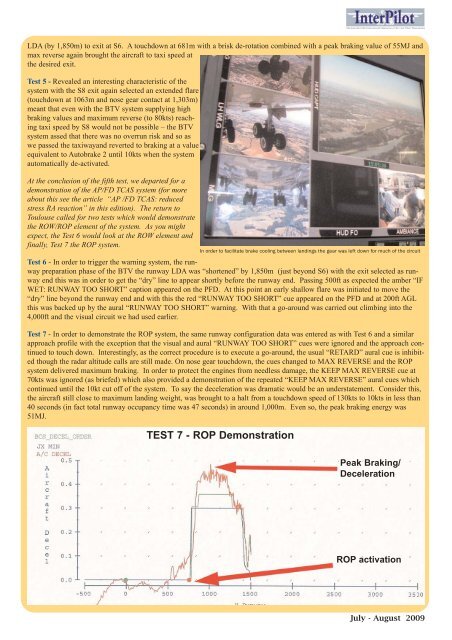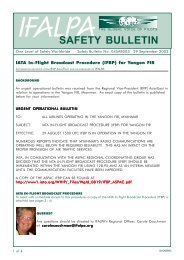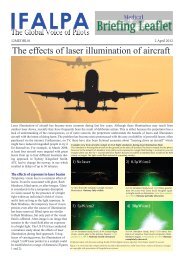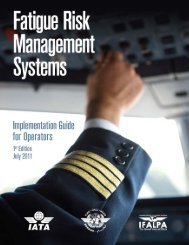You also want an ePaper? Increase the reach of your titles
YUMPU automatically turns print PDFs into web optimized ePapers that Google loves.
LDA (by 1,850m) to exit at S6. A touchdown at 681m with a brisk de-rotation combined with a peak braking value of 55MJ and<br />
max reverse again brought the aircraft to taxi speed at<br />
the desired exit.<br />
Test 5 - Revealed an interesting characteristic of the<br />
system with the S8 exit again selected an extended flare<br />
(touchdown at 1063m and nose gear contact at 1,303m)<br />
meant that even with the BTV system supplying high<br />
braking values and maximum reverse (to 80kts) reaching<br />
taxi speed by S8 would not be possible – the BTV<br />
system assed that there was no overrun risk and so as<br />
we passed the taxiwayand reverted to braking at a value<br />
equivalent to Autobrake 2 until 10kts when the system<br />
automatically de-activated.<br />
At the conclusion of the fifth test, we departed <strong>for</strong> a<br />
demonstration of the AP/FD TCAS system (<strong>for</strong> more<br />
about this see the article “AP /FD TCAS: reduced<br />
stress RA reaction” in this edition). The return to<br />
Toulouse called <strong>for</strong> two tests which would demonstrate<br />
the ROW/ROP element of the system. As you might<br />
expect, the Test 6 would look at the ROW element and<br />
finally, Test 7 the ROP system.<br />
In order to facilitate brake cooling between landings the gear was left down <strong>for</strong> much of the circuit<br />
Test 6 - In order to trigger the warning system, the runway<br />
preparation phase of the BTV the runway LDA was “shortened” by 1,850m (just beyond S6) with the exit selected as runway<br />
end this was in order to get the “dry” line to appear shortly be<strong>for</strong>e the runway end. Passing 500ft as expected the amber “IF<br />
WET: RUNWAY TOO SHORT” caption appeared on the PFD. At this point an early shallow flare was initiated to move the<br />
“dry” line beyond the runway end and with this the red “RUNWAY TOO SHORT” cue appeared on the PFD and at 200ft AGL<br />
this was backed up by the aural “RUNWAY TOO SHORT” warning. With that a go-around was carried out climbing into the<br />
4,000ft and the visual circuit we had used earlier.<br />
Test 7 - In order to demonstrate the ROP system, the same runway configuration data was entered as with Test 6 and a similar<br />
approach profile with the exception that the visual and aural “RUNWAY TOO SHORT” cues were ignored and the approach continued<br />
to touch down. Interestingly, as the correct procedure is to execute a go-around, the usual “RETARD” aural cue is inhibited<br />
though the radar altitude calls are still made. On nose gear touchdown, the cues changed to MAX REVERSE and the ROP<br />
system delivered maximum braking. In order to protect the engines from needless damage, the KEEP MAX REVERSE cue at<br />
70kts was ignored (as briefed) which also provided a demonstration of the repeated “KEEP MAX REVERSE” aural cues which<br />
continued until the 10kt cut off of the system. To say the deceleration was dramatic would be an understatement. Consider this,<br />
the aircraft still close to maximum landing weight, was brought to a halt from a touchdown speed of 130kts to 10kts in less than<br />
40 seconds (in fact total runway occupancy time was 47 seconds) in around 1,000m. Even so, the peak braking energy was<br />
51MJ.<br />
TEST 7 - ROP Demonstration<br />
Peak Braking/<br />
Deceleration<br />
ROP activation<br />
July - August 2009





